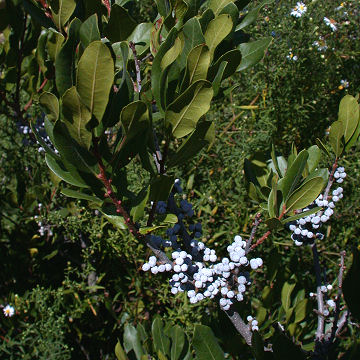

Morella pensylvanica - (image 1 of 4)
Taxonomy
Family: Myricaceae
Habitat
Dry hills and shores. Most frequent along the Atlantic coast.
Associates
Distribution
Along the coast from Newfoundland to NC, inland to PA, OH, and Ontario.
Morphology
Spreading shrub to 2 m. Leaves deciduous, with resinous glands, oblanceolate to elliptic, entire or shallowly toothed near the rounded, minutely apiculate tip. Staminate catkins cylindric with quadrate bracts; pistillate catkins slender with ovate bracts; ovary densely hairy. Fruit a rounded nutlet, solitary or clusters, covered in a thick, whitish wax and dense, short hairs.
Notes
Flowers May or June
Wetland indicator: Facultative
The leaves can be used as a replacement for commercial bay leaves. The aromatic, waxy fruits can be boiled and the extracted wax made into candles.
Synonymous with Myrica pensylvanica Mirb.
References
Gleason, Henry A. and A. Cronquist. 1991. Manual of Vascular Plants of
Northeastern United States
and Adjacent Canada. Second Ed.
The New York Botanical Garden. Bronx, NY
Peterson, L. A. 1977. A Field Guide to Edible Wild Plants: Eastern and central North America
Houghton Mifflin Company. New York, NY
USDA, NRCS. 2002.
The PLANTS Database, Version 3.5 (http://plants.usda.gov).
National Plant Data Center, Baton Rouge, LA 70874-4490 USA.
|
Michael Hough © 2009 |